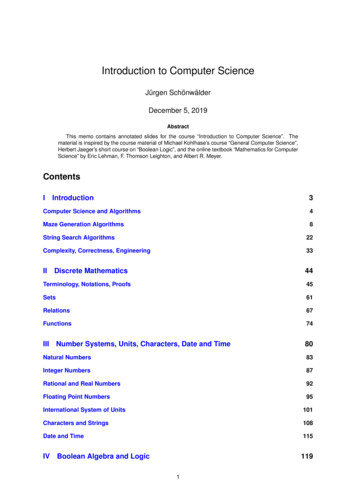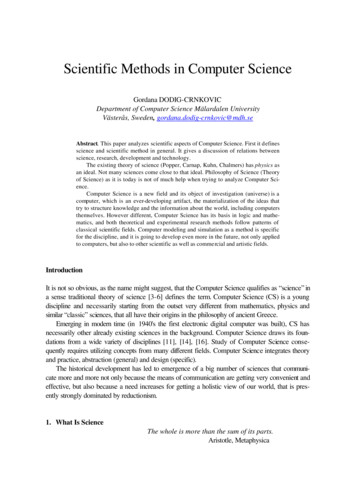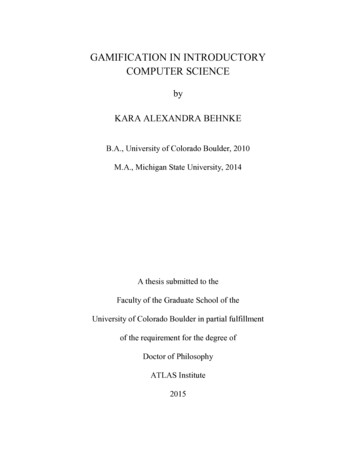
Transcription
Introduction to Computer ScienceJürgen SchönwälderDecember 5, 2019AbstractThis memo contains annotated slides for the course “Introduction to Computer Science”. Thematerial is inspired by the course material of Michael Kohlhase’s course “General Computer Science”,Herbert Jaeger’s short course on “Boolean Logic”, and the online textbook “Mathematics for ComputerScience” by Eric Lehman, F. Thomson Leighton, and Albert R. Meyer.ContentsIIntroduction3Computer Science and Algorithms4Maze Generation Algorithms8String Search Algorithms22Complexity, Correctness, Engineering33II44Discrete MathematicsTerminology, Notations, Proofs45Sets61Relations67Functions74III80Number Systems, Units, Characters, Date and TimeNatural Numbers83Integer Numbers87Rational and Real Numbers92Floating Point Numbers95International System of Units101Characters and Strings108Date and Time115IVBoolean Algebra and Logic1191
Elementary Boolean Operations and Functions121Boolean Functions and Formulas132Boolean Algebra Equivalence Laws138Normal Forms (CNF and DNF)143Complexity of Boolean Formulas150Boolean Logic and the Satisfiability Problem156VComputer Architecture161Logic Gates and Digital Circuits162Sequential Digital Circuits173Von Neumann Computer Architecture183VISystem Software191Interpreter and Compiler192Operating Systems204VIISoftware Correctness213Software Specification214Software Verification226Automation of Software Verification2382
Part IIntroductionThe aim of this part is to explain what computer science is all about. After the introduction of a fewterms, we will study two typical problems, namely the creation of mazes and the search of a pattern ina string. We will demonstrate that it is useful to look at the problem from different perspectives in orderto find good algorithms to solve the problem.3
Section 1: Computer Science and Algorithms1Computer Science and Algorithms2Maze Generation Algorithms3String Search Algorithms4Complexity, Correctness, EngineeringJürgen Schönwälder (Jacobs University Bremen)Introduction to Computer Science4December 5, 201915 / 256
Computer Science Computer science is the study of the principles and use of computers.[Oxford Dictionary, September 2018] Computer science is a branch of science that deals with the theory of computationor the design of computers.[Merriam Webster, September 2018] Computer science is the study of the theory, experimentation, and engineering thatform the basis for the design and use of computers.[Wikipedia, September 2018] Computer science is the study of computers, including both hardware and softwaredesign.[Webopedia, September 2018]Jürgen Schönwälder (Jacobs University Bremen)Introduction to Computer ScienceDecember 5, 2019Further information: https://en.wikipedia.org/wiki/Computer science Defining Computer Science (ACM SIGCSE Bulletin, Vol. 32, Issue 2, June 2000)516 / 256
AlgorithmDefinition (algorithm)In computer science, an algorithm is a self-contained sequence of actions to beperformed in order to achieve a certain task. If you are confronted with a problem, do the following steps: first think about the problem to make sure you fully understand it afterwards try to find an algorithm to solve the problem try to assess the properties of the algorithms (will it handle corner cases correctly?how long will it run? will it always terminate?, . . . ) consider possible alternatives that may have “better” properties finally, write a program to implement the most suitable algorithm you have selected Is the above an algorithm to find algorithms?Jürgen Schönwälder (Jacobs University Bremen)Introduction to Computer ScienceDecember 5, 201917 / 256The notion of an algorithm is central to computer science. Computer science is all about algorithms. Aprogram is an implementation of an algorithm. While programs are practically important (since you canexecute them), we often focus in computer science on the algorithms and their properties and less onthe concrete implementations of the algorithms.Another important aspect of computer science is the definition of abstractions that allow us to describeand implement algorithms efficiently. A good education in computer science will (i) strengthen yourabstract thinking and (ii) train you in algorithmic thinking.Some algorithms are very old. Algorithms were used in ancient Greek, for example the Euclideanalgorithm to find the greatest common divisor of two numbers. Marks on sticks were used beforeRoman numerals were invented. Later in the 11th century, Hindu–Arabic numerals were introduced intoEurope that we still use today.The word algorithm goes back to Muhammad ibn Musa al-Khwarizmi, a Persian mathematician, whowrote a document in Arabic language that got translated into Latin as “Algoritmi de numero Indorum”.The Latin word was later altered to algorithmus, leading to the corresponding English term ’algorithm’.For further information: https://en.wikipedia.org/wiki/Algorithm6
Algorithmic ThinkingAlgorithmic thinking is a collection of abilities that are essential for constructing andunderstanding algorithms: the ability to analyze given problems the ability to specify a problem precisely the ability to find the basic actions that are adequate to the given problem the ability to construct a correct algorithm using the basic actions the ability to think about all possible special and normal cases of a problem the ability to assess and improve the efficiency of an algorithmJürgen Schönwälder (Jacobs University Bremen)Introduction to Computer ScienceDecember 5, 201918 / 256We will train you in algorithmic thinking. This is going to change how you look at the world. You will startto enjoy (hopefully) the beauty of well designed abstract theories and elegant algorithms. You will startto appreciate systems that have a clean and pure logical structure.But beware that the real world is to a large extend not based on pure concepts. Human natural language is very imprecise, sentences often have different interpretations in different contexts, and the realmeaning of a statement often requires to know who made the statement and in which context. Makingcomputers comprehend natural language is still a hard problem to be solved.Example: Consider the following problem: Implement a function that returns the square root of a number(on a system that does not have a math library). At first sight, this looks like a reasonably clear definitionof the problem. However, on second thought, we discover a number of questions that need furtherclarification. What is the input domain of the function? Is the function defined for natural numbers, integernumbers, real numbers (or an approximate representation of real numbers), complex numbers? Are we expected to always return the principal square root, i.e., the positive square root? What happens if the function is called with a negative number? Shall we return a complex numberor indicate a runtime exception? In the later case, how exactly is the runtime exception signaled? In general, square roots can not be calculated and represented precisely (recall that 2 is irrational). Hence, what is the precision that needs to be achieved?While thinking about a problem, it is generally useful to go through a number of examples. The examplesshould cover regular cases and corner cases. It is useful to write the examples down since they mayserve later as test cases for an implementation of an algorithm that has been selected to solve theproblem.For further information: Algorithmic Thinking: The Key for Understanding Computer Science Misconceptions About Computer Science7
Section 2: Maze Generation Algorithms1Computer Science and Algorithms2Maze Generation Algorithms3String Search Algorithms4Complexity, Correctness, EngineeringJürgen Schönwälder (Jacobs University Bremen)Introduction to Computer Science8December 5, 201919 / 256
Maze (33 x 11)[] [][][][][][][] [][][][][][] [] [][][][][][][] [] [][][] [][][][][] [][][] [] [] [][][][] [] [] [][][][] [][][][][][][][] [] [] [] [] [][][][][] [] [] [][][][][] [][][][] [][] [][] [] [] [] [][][] [] [] [][][] [][][][][] [] [] [] [][][] [] [] [][][][] [][][] [][][] [] [] [][] [][][][][][][][][][][][][][][] [][][][][] [][][] [] [] [][][][][][][][][][] []Jürgen Schönwälder (Jacobs University Bremen)Introduction to Computer ScienceDecember 5, 201920 / 256This is a simple 33x11 maze. How do you find a path through the maze from the entry (left top) to theexit (bottom right)?We are not going to explore maze solving algorithms here. Instead we look at the generation of mazes.For further information: https://en.wikipedia.org/wiki/Maze solving algorithm9
Problem StatementProblem: Write a program to generate mazes. Every maze should be solvable, i.e., it should have apath from the entrance to the exit. We want maze solutions to be unique. We want every “room” to be reachable.Questions: How do we approach this problem? Are there other properties that make a maze a “good”or a “challenging” maze?Jürgen Schönwälder (Jacobs University Bremen)Introduction to Computer ScienceDecember 5, 201921 / 256It is quite common that problem statements are not very precise. A customer might ask for “good” mazesor “challenging” mazes or mazes with a certain “difficulty level” without being able to say precisely whatthis means. As a computer scientist, we appreciate well defined requirements but what we usually getis imprecise and leaves room for interpretation.What still too often happens is that the computer scientist discovers that the problem is under-specifiedand then decides to go ahead to produce a program that, according to his understanding of the problem,seems to close the gaps in a reasonable way. The customer then later sees the result and is oftendisappointed by the result. To avoid such negative surprises, it is crucial to reach out to the customer ifthe problem definition is not precise enough.10
Hacking. . .Jürgen Schönwälder (Jacobs University Bremen)Introduction to Computer ScienceDecember 5, 201922 / 256While hacking can be fun, it is often far more effective to think first before opening the editor and startingto write code. It often also helps to discuss the problem with others. Even coding together in pairs of two(pair programming) has been found to lead to better programs. Despite common believes, computerscience in practice usually means a lot of team work and requires a great deal of communication.For further information: https://en.wikipedia.org/wiki/Pair programming11
Problem Formalization (1/3) Think of a maze as a (two-dimensional) grid of roomsseparated by walls. Each room can be given a name. Initially, every room is surrounded by four walls General idea: Randomly knock out walls until we get a good maze.How do we ensure there is a solution?How do we ensure there is a unique solution?How do we ensure every room is reachable?Jürgen Schönwälder (Jacobs University Bremen)Introduction to Computer ScienceabcdefghijklmnopDecember 5, 201923 / 256Thinking of a maze as a (two-dimensional) grid seems natural, probably because we are used to twodimensional mazes in the real world since childhood.But what about one-dimensional mazes? Are they useful?What about higher-dimensional mazes? Should we generalize the problem to consider arbitrary ndimensional mazes? Quite surprisingly, generalizations sometimes lead to simpler solutions. As we willsee later, the dimensionality of the maze does not really matter much.12
Problem Formalization (2/3)Lets try to formalize the problem in mathematical terms: We have a set V of rooms. We have a set E of pairs (x, y ) with x V and y Vof adjacent rooms that have an open wall between them.In the example, we have V {a, b, c, d, e, f , g , h, i, j, k, l, m, n, o, p} (a, b) E and (g , k) E and (a, c) / E and (e, f ) /EAbstractly speaking, this is a mathematical structure called agraph consisting of a set of vertices (also called nodes) and aset of edges (also called links).Jürgen Schönwälder (Jacobs University Bremen)abcdefghijklmnopIntroduction to Computer ScienceDecember 5, 201924 / 256Graphs are very fundamental in computer science. Many real-world structures and problems have agraph representation. Relatively obvious are graphs representing the structure of relationships in socialnetworks or graphs representing the structure of communication networks. Perhaps less obvious is thatcompilers internally often represent source code as graphs.Note: What is missing in this problem formalization is how we represent (or determine) that two roomsare adjacent. (This is where the dimensions of the space come in.)For further information: https://en.wikipedia.org/wiki/Graph (discrete mathematics)13
Why use a mathematical formalization? Data structures are typically defined as mathematical structures Mathematics can be used to reason about the correctness and efficiency of datastructures and algorithms Mathematical structures make it easier to think — to abstract away fromunnecessary details and to avoid “hacking”Jürgen Schönwälder (Jacobs University Bremen)Introduction to Computer ScienceDecember 5, 201925 / 256Formalizing a problem requires us to think abstractly about what needs to be done. It requires us toidentify clearly what our input is, what our output is, and what the task is that needs to be achieved.Formalization also leads to a well-defined terminology that can be used to talk about the problem.Having a well-defined terminology is crucial for any teamwork. Without it, a lot of time is wasted becausepeople talk past each other, often without discovering it. Keep in mind that larger programs are almostalways the result of teamwork.14
Problem Formalization (3/3)Definition: A maze is a graph G (V , E ) with two special nodes,the start node S and the exit node X .Interpretation: Each graph node x V represents a room An edge (x, y ) E indicates that rooms x and y areadjacent and there is no wall in between them The first special node is the start of the maze The second special node is the exit of the mazeJürgen Schönwälder (Jacobs University Bremen)Introduction to Computer ScienceabcdefghijklmnopDecember 5, 201926 / 256Another way of formulating this is to say that a maze is described by a triple (G, S, X) where G (V, E)is a graph with the vertices V and the edges E and S V is the start node and X V is the exit node.Given this formalization, the example maze is represented as follows: V {a, b, c, d, e, f, g, h, i, j, k, l, m, n, o, p} E {(a, b), (a, e), (b, c), (d, h), (e, i), (f, g), (f, j), (g, h), (g, k), (i, j), (k, o), (l, p), (m, n), (n, o), (o, p)} S a X pNote that this is just one out of many different possible representations of the problem. Finding agood representation of a given problem requires experience and knowledge of many different possiblerepresentation approaches.15
Mazes as Graphs (Visualization via Diagrams) Graphs are very abstract objects, we need a good,intuitive way of thinking about them. We use diagrams, where the nodes are visualized ascircles and the edges as lines between them. Note that the diagram is a visualization of the graph,and not the graph itself. A visualization is a representation of a structure intendedfor humans to process visually.Jürgen Schönwälder (Jacobs University Bremen)abcdefghijklmnopIntroduction to Computer ScienceDecember 5, 201927 / 256Visualizations help humans to think about a problem. The human brain is very good in recognizingstructures visually. But note that a visualization is just another representation and it might not be thebest representation for a computer program. Also be aware that bad visualizations may actually hidestructures.Graphs like the one discussed here can also be represented using a graph notation. Here is how thegraph looks like in the dot notation (used by the graphviz tools):graph maze {a -a -g -g -o -o --behkmp-------c;i -- f -- g;d;o;n;l;// S an X are additional invisible nodes with an edge// to the start and exit nodes.S [style invis]S -- aX [style invis]p -- X}Several graph drawing tools can read graph representations in dot notation and produce drawings ofthe graph. Note that producing good drawings for a given graphs is a non-trivial problem. You can lookat different drawings of the graph by saving the graph definition in a file (say maze.dot) and then run thefollowing commands to produce .pdf files (assuming you have the graphviz software package installed). neato -T pdf -o maze-neato.pdf maze.dot dot -T pdf -o maze-dot.pdf maze.dotFor further information: https://en.wikipedia.org/wiki/Graph drawing http://www.graphviz.org/16
Mazes as Graphs (Good Mazes)Recall, what is a good maze? We want maze solutions to be unique. We want every room to be reachable.Solution: The graph must be a tree (a graph with a unique rootnode and every node except the root node having aunique parent). The tree should cover all nodes (we call such a tree aspanning tree).Since trees have no cycles, we have a unique solution.Jürgen Schönwälder (Jacobs University Bremen)Introduction to Computer ScienceabcdefghijklmnopDecember 5, 201928 / 256Apparently, we are not interested in arbitrary graphs but instead in spanning trees. So we need to solvethe problem to construct a spanning tree rooted at the start node. This turns out to be a fairly generalproblem which is not specific to the construction of mazes.Note that in graph theory, a spanning tree T of an undirected graph G is a subgraph that is a tree whichincludes all of the vertices of G, with minimum possible number of edges. In general, a graph may haveseveral spanning trees.Spanning trees are important for communication networks in order to avoid loops. Spanning trees arealso often used as building blocks in more complex algorithms.Computer scientists draw trees in a somewhat unconventional fashion: The root is usually at the topand the tree grows towards the bottom.For further information: https://en.wikipedia.org/wiki/Spanning tree17
Kruskal’s Algorithm (1/2)General approach: Randomly add a branch to the tree if it won’t create a cycle (i.e., tear down a wall). Repeat until a spanning tree has been created.Questions: When adding a branch (edge) (x, y ) to the tree, how do we detect that the branchwon’t create a cycle? When adding an edge (x, y ), we want to know if there is already a path from x toy in the tree (if there is one, do not add the edge (x, y ). How can we quickly determine whether there is already a path from x to y ?Jürgen Schönwälder (Jacobs University Bremen)Introduction to Computer ScienceFor further information: https://en.wikipedia.org/wiki/Kruskal%27s algorithm18December 5, 201929 / 256
Kruskal’s Algorithm (2/2)The Union Find Algorithm successively puts nodes into an equivalence class if there is apath connecting them. With this idea, we get the following algorithm to construct aspanning tree:1. Initially, every node is in its own equivalence class and the set of edges is empty.2. Randomly select a possible edge (x, y ) such that x and y are not in the sameequivalence class.3. Add the edge (x, y ) to the tree and join the equivalence classes of x and y .4. Repeat the last two steps if there are still multiple equivalence classes.Jürgen Schönwälder (Jacobs University Bremen)Introduction to Computer ScienceDecember 5, 201930 / 256The following Haskell program (Listing 1) is calculating a spanning tree, following the ideas of the algorithm outlined on the slide. The implementation is not making a random selection and hence it producesalways the same spanning tree for a given graph. (You are not expected to understand the code yet;but you should be able to do so the end of the semester.)For further information: https://en.wikipedia.org/wiki/Equivalence class https://en.wikipedia.org/wiki/Disjoint-set data structure19
12{- Module: maze/Maze.hs345Calculate a spanning tree (a maze) over a given graph.-}67module Maze (Node, Edge, Graph, maze, showDot) where89import Data.List1011121314typetypetypetypeNode CharEdge (Node, Node)Graph ([Node], [Edge])Class [Node]15161718192021-- Take a graph and return a spanning tree graph (a maze) by calling-- buildMaze with a set of equivalence classes (one for each node) and-- a new graph that initially has only nodes but no edges.maze :: Graph - Graphmaze g buildMaze g (map (:[]) ns) (ns, [])where (ns,es) g2223242526272829303132-- Take a graph, a list of node equivalence classes, a new (spanning-- tree) graph (which we are building up) and return a spanning tree-- graph if only one equivalence is left. Otherwise, find an edge and-- continue building the spanning tree by merging the classes-- connected by the edge and adding the edge to the spanning tree.buildMaze :: Graph - [Class] - Graph - GraphbuildMaze g cs (ns,es) length cs 1 (ns,es) otherwise buildMaze g (mergeClasses cs e) (ns,e:es)where e findEdge cs (snd g)3334353637383940-- Given a list of classes and edges, find an edge that connects two-- equivalence classes. We pick the first edge is there are multiple-- but this could also be a random selection. The distinct helper-- function tests where an edge connects two equivalence classes.findEdge :: [Class] - [Edge] - EdgefindEdge cs es head (filter (distinct cs) es)where distinct cs (a,b) filter (elem a) cs / filter (elem b) cs414243444546474849505152-- Given a list of equivalence classes and an edge, merge equivalence-- classes given a specific edge by partitioning the classes into-- those touched by the edge and those not touched by the edge. Concat-- (join) the touched edges and then return the new list of-- equivalence classes. The match helper function tests whether an-- edge matches an equivalence class (i.e., whether any of the-- endpoints is in the equivalence class.mergeClasses :: [Class] - Edge - [Class]mergeClasses cs e concat m : nwhere (m,n) partition (match e) cswhere match (a,b) c elem a c elem b c53545556575859606162-- Show a graph in the dot notation.showDot :: Graph - StringshowDot (ns,es) "graph xyz {" (concat (map showNode ns)) (concat (map showEdge es)) "}"where showNode n [n] ";"showEdge e [a] "--" [b]20 ";"where (a,b) e6364-- Read a graph from the dot notation. TBD.
Randomized Depth-first SearchAre there other algorithms? Of course there are. Here is a different approach to build atree rooted at the start node.1. Make the start node the current node and mark it as visited.2. While there are unvisited nodes:2.1 If the current node has any neighbours which have not been visited:2.1.12.1.22.1.32.1.4Choose randomly one of the unvisited neighboursPush the current node to the stack (of nodes)Remove the wall between the current node and the chosen nodeMake the chosen node the current node and mark it as visited2.2 Else if the stack is not empty:2.2.1 Pop a node from the stack (of nodes)2.2.2 Make it the current nodeJürgen Schönwälder (Jacobs University Bremen)Introduction to Computer ScienceFor further information: https://en.wikipedia.org/wiki/Maze generation algorithm21December 5, 201931 / 256
Section 3: String Search Algorithms1Computer Science and Algorithms2Maze Generation Algorithms3String Search Algorithms4Complexity, Correctness, EngineeringJürgen Schönwälder (Jacobs University Bremen)Introduction to Computer Science22December 5, 201932 / 256
Problem StatementProblem: Write a program to find a (relatively short) string in a (possibly long) text. This is sometimes called finding a needle in a haystack.Questions: How can we do this efficiently? What do we mean with long? What exactly is a string and what is text?Jürgen Schönwälder (Jacobs University Bremen)Introduction to Computer ScienceDecember 5, 201933 / 256Searching is one of the main tasks computers do for us. Searching in the Internet for web pages. Searching within a web page for a given pattern. Searching for a pattern in network traffic. Searching for a pattern in a DNA.The search we are considering is more precisely called substring search. There are more expressivesearch techniques that we do not consider here.For further information: https://en.wikipedia.org/wiki/String searching algorithm23
Problem Formalization Let Σ be a finite set, called an alphabet.Let k denote the number of elements in Σ.Let Σ be the set of all words that can be created out of Σ (Kleene closure of Σ).Let t Σ be a (possible long) text and p Σ be a (typically short) pattern.Let n denote the length of t and m denote the length of p.We assume that n m.Find the first occurance of p in t.Jürgen Schönwälder (Jacobs University Bremen)Introduction to Computer ScienceDecember 5, 201934 / 256The formalization introduces common terms that make it easier to discuss the problem. Furthermore,we introduce the abstract notion of an alphabet and we do not care anymore about the details how suchan alphabet looks like. Some examples for alphabets: The characters of the Latin alphabet. The characters of the Universal Coded Character Set (Unicode) The binary alphabet Σ {0, 1}. The DNA alphabet Σ {A, C, G, T } used in bioinformatics.The Kleene closure Σ of the alphabet Σ is the (infinite) set of all words that can be formed with elementsout of Σ. This includes the empty word of length 0, typically denoted by . Note that words here are anyconcatenation of elements of the alphabet, it does not matter whether the word is meaningful or not.Note that the problem formalization details that we are searching for the first occurance of p in t. Wecould have defined the problem differently, e.g., searching for the last occurance of p in t, or searchingfor all occurances of p in t.24
Naive String Search Check whether the pattern matches at each text position (going left to right). Lowercase characters indicate comparisons that were skipped. Example: t FINDANEEDLEINAHAYSTACK, p NEEDLEF I N D A N E E D L E I N A H A Y S T A C KN e e dN e eN ENldeeNeldeeNeldeEel ed l eE D L EJürgen Schönwälder (Jacobs University Bremen)Introduction to Computer ScienceDecember 5, 201935 / 256An implementation of naive string search in an imperative language like C is straight forward (seeListing 2). You need two nested for-loops, the outer loop iterates over all possible alignments and theinner loop iterates over the pattern to test whether the pattern matches the current part of text.12{- Module: naive-search/Search.hs3456Search for a substring in a text using the naive search algorithm.-}module Search (findFirstIn, isPrefixOf) Of:: Eq a [a] - [a] - Bool[] True[] False(x:xs) (y:ys) (x y) && isPrefixOf xs ys121314151617181920findFirstIn :: Eq a [a] - [a] - IntfindFirstIn cntFindFirstIn 0wherecntFindFirstIn :: Eq a Int - [a] - [a] - IntcntFindFirstIn [] -1cntFindFirstIn n p t p isPrefixOf t n otherwise cntFindFirstIn (n 1) p (tail t)21Listing 2: Naive string search implemented in Haskell25
Naive String Search Performance How “fast” is naive string search? Idea: Lets try to count the number of comparisons. Problem: The number of comparisons depends on the strings. Idea: Consider the worst case possible. What is the worst case possible? Consider a haystack of length n using only a single symbol of the alphabet (e.g.,“aaaaaaaaaa” with n 10). Consider a needle of length m which consists of m 1 times the same symbolfollowed by a single symbol that is different (e.g., “aax” with m 3). With n m, the number of comparisons needed will be roughly n · m.Jürgen Schönwälder (Jacobs University Bremen)Introduction to Computer ScienceDecember 5, 201936 / 256When talking about the performance of an algorithm, it is often useful to consider performance in thebest case, performance in the worst case, and performance in average cases. Furthermore, performance is typically discussed in terms of processing steps (time) and in terms of memory required(space). There is often an interdependency between time and space and it is often possible to tradespace against time or vice versa.The naive string search is very space efficient but not very time efficient. Alternative search algorithmscan be faster, but they require some extra space.26
Boyer-Moore: Bad character rule (1/2) Idea: Lets compare the pattern right to left instead left to right. If there is amismatch, try to move the pattern as much as possible to the right. Bad character rule: Upon mismatch, move the pattern to the right until there is amatch at the current position or until the pattern has moved past the currentposition. Example: t FINDANEEDLEINAHAYSTACK, p NEEDF I N D A N E E D L E I N A H A Y S T A C Kn e E Dn e e DN E E DJürgen Schönwälder (Jacobs University Bremen)skip12Introduction to Computer ScienceDecember 5, 201937 / 256The bad character rule allows us to skip alignments:1. In the initial alignment, we find that D is matching but E is not matching the N. So we checkwhether there is an N in the part of the pattern not tested yet that we can align with the N. In thiscase there is an N in the pattern and we can skip 1 alignment.2. In the second alignment, we find that D is not matching N and so we check whether there is an Nin the part of the pattern not tested yet. In this case, we can skip 2 alignments.3. In the third alignment, we find a match.In this case, we have skipped 3 alignments and we used 3 alignments to find a match. With the naivealgorithm we would have used 6 alignments. We have performed 7 comparisons in this case while thenaive algorithm used 12 comparisons.27
Boyer-Moore: Bad character rule (2/2) Example: t FINDANEEDLEINAHAYS
Computer Science Computer science is the study of the principles and use of computers. [Oxford Dictionary, September 2018] Computer science is a branch of science that deals with the theory of computation or the design of computers. [Merriam Webster, September 2018] Computer science is the s










